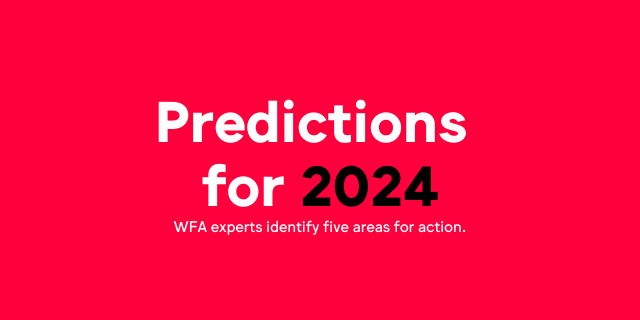Get analysis, insight & opinions from the world's top marketers.
Sign up to our newsletter.
The WFA’s experts identify five areas for action in the year to come.

After COP28, it’s time for the work to begin. Whilst both environmental and social sustainability are as high profile as ever, sustainability has been in decline for the past two years.
This is a familiar pattern that has been seen before on all transformational topics. After a peak in hype, the realisation of the complexity of the challenge facing marketing before it can be part of the solution to a sustainable future dawns. In 2024 marketing leaders need to start putting commitments and promises into action.
Expect to see sustainability become a new media currency and KPI as media leaders start to benchmark how their work lines up with their organization’s broader sustainability efforts.
Media leaders will segment partners, benchmark and reduce emissions as Scope 3 emissions become an increasing focus for global enterprises. In order to play their part, media leaders will be using the procurement and sustainability playbook from other areas of the business to challenge the media ecosystem.
As new standards are introduced via GARM and as data is more accurate and attributable to media products, marketers and the industry as a whole will gain increased visibility, control and confidence in their sustainability efforts.
Smart marketers will put responsibility at the top of their KPIs in 2024 whether that relates to how they select their purpose, their influencer partners or the media platforms they use as they seek to protect brand value.
Brand owners realise the responsibility they have (to people and planet as well as shareholders) and the accountability they face and will put an increased focus on ‘being a better brand'.
Expect to see a debate over Safeguards vs Controls as elections and the democratic process as well as the need to protect children force even the most hesitant to look at content recommendation engines. More progressive stakeholders and markets will look to not just create limitations but give users control.
Media leaders have started to do the right things in managing where ads show up, but underlying technology will get a much more detailed examination. Business leaders and regulators will be looking at underlying technology – algorithms and artificial intelligence – to determine how they will protect themselves, their stakeholders, citizens and their brandmarks.
There will be a good deal of handwringing on developing adequate safeguards as well as opportunity for those who tackle this area first. Expect to see an Atlantic divide between the US and EU in this area.
In 2023, generative AI took the industry by storm, promising opportunities for more creative, personalised and effective marketing. According to our research, over three-quarters of brand owners are using or plan to use generative AI in their marketing strategies.
It’s not just about dynamic creative and media optimization but also, echoing our earlier themes, safety and responsibility. Brands will need to take new measures to protect their brands from brandjacking and will request that platforms start to treat them like IP owners and adopt provenance indicators.
These legitimate requests will make brand safety leaders more ready to flag synthetic media and manipulated media. Content review systems will be needed as a means of helping sort through a new volume of content queuing for entertainment and commercial purposes.
AI is the next element in the acceleration of digital transformation, but marketers must avoid rushing into the latest tech without thinking of transformation and everything that it implies, including integration.
While some of the amazing AI ideas will work and become showpiece items at industry conferences, the real changes AI creates will be less dramatic, slower to land but more pervasive.
Regulators have been quick to tackle this area and the EU has just agreed to new rules with the ambition of driving the transparent, safe and responsible use of AI. And while these and subsequent rules may not target marketing directly, they will require marketers to be transparent to users about their use of AI.
In 2023 we’ve seen fines affecting the entire advertising ecosystem, from major platforms such as Meta and TikTok, to ad tech intermediaries, and even brands.
As global data protection rules continue to emerge and tighten, many of which restrict online behavioural advertising, all eyes will be on how the industry will adapt.
Meta is already rolling out a subscription model in the EU, which will require users to either pay a fee for ad-free versions of Instagram or Facebook or consent to having their data used for personalised advertising purposes. TikTok may follow suit.
While privacy activists and consumer organisations have already exclaimed their disapproval, regulators remain the ultimate decision makers. And next year will be key to providing clarity about whether platforms responses thus far have been sufficient, or whether we need a wholesale overhaul of digital advertising practices.
The platform formerly known as Twitter may provide the first test of regulators’ desire to take on big tech over issues beyond privacy and child protection.
Much has been said, not least by the IPA and Peter Field, around the decline in marketing communications creativity. With so much emphasis on the need to address this and with the additional pressure, and opportunity, which marketers see in generative AI, that the pressure to brief better and evaluate more effectively should go some way help to address this decline.
We hope to see better marketing in 2024, whether created or supported by AI or human hands.